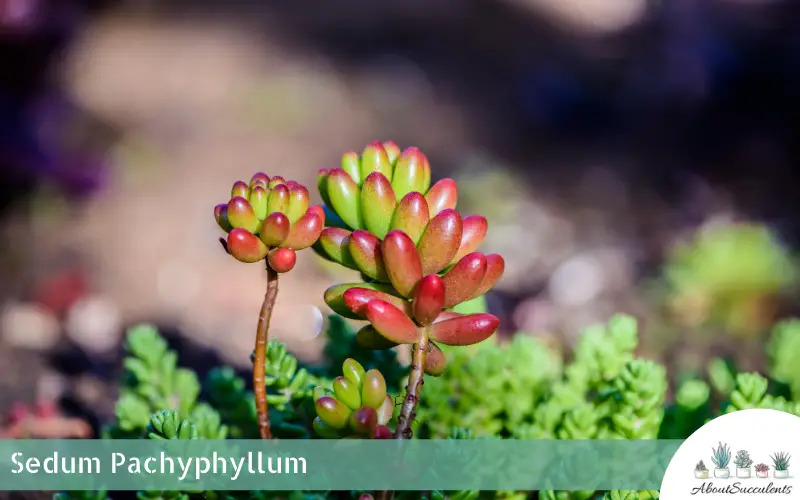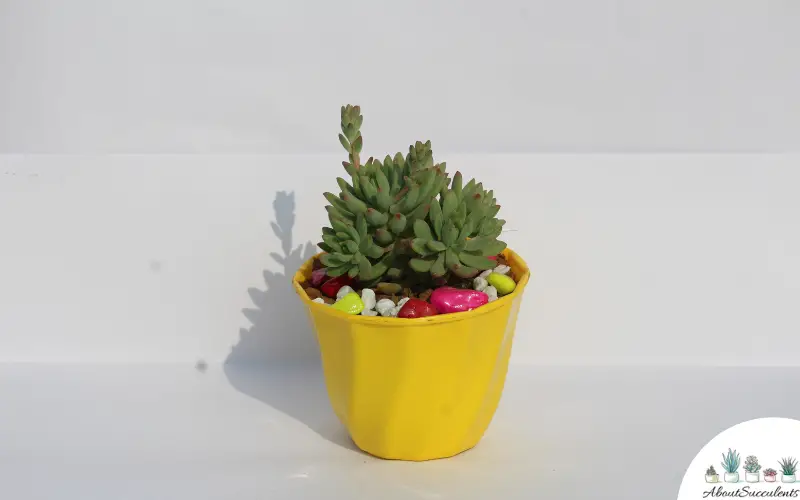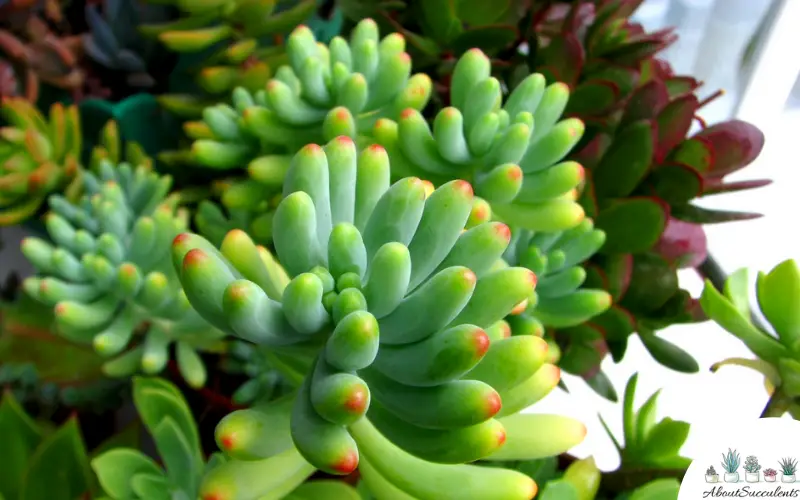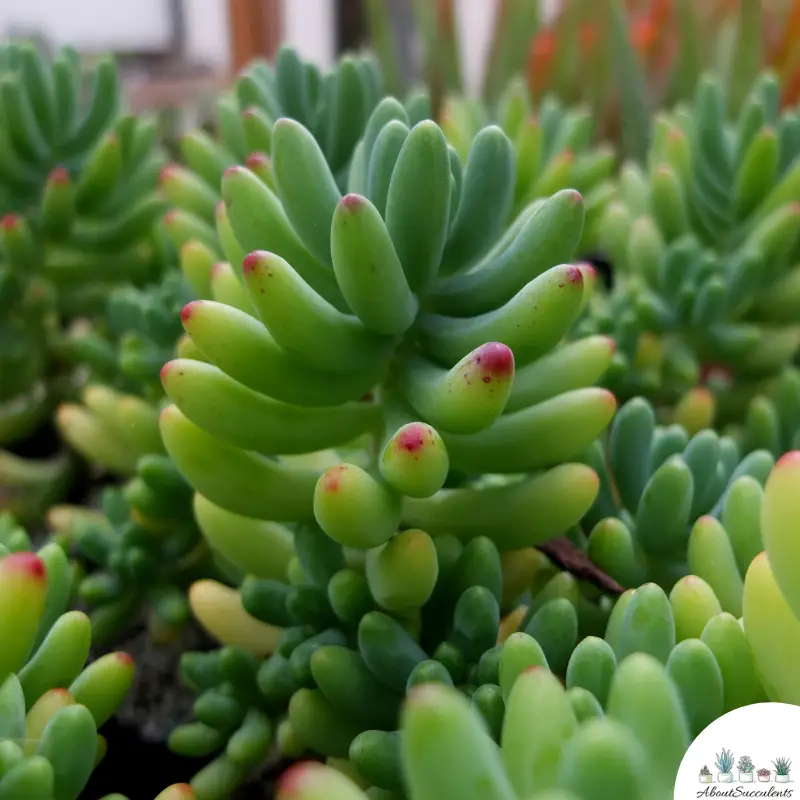
Sedum pachyphyllum is a ground-hugging succulent that spreads by rooting fallen stems and leaves. The succulent also goes by the names “Jelly Beans”, “Many Fingers”, and “Blue Jelly Beans” because of its short and stumpy leaves that give it an appearance of fingers made of jelly beans.
Jelly Beans’ finger-like leaves have a light silvery-green color; positioned at a right angles to the stem, curve upward and are 0.39 to 1.57-inches (1cm to 4cm) long and 0.23 to 0.39-inches wide. Sedum pachyphyllum can reach a height of 11-inches or 30cm. In the wintertime, the tips of Jelly Beans’ leaves will turn red.
Sedum pachyphyllum originates from the Crassulaceae family and is native to Mexico.
General Information:
Also known as: Jelly Beans, Christmas Cheer, Pork and Beans
Plant Family: Crassulaceae
Origin: Mexico
Height: 12-inches (30cm)
Exposure: Full to partial sunlight up to 6 hours per day
Water Needs: Light watering schedule during the summer months; very little to no watering in the winter or cold season.
Soil Type: Cactus soil or soil mix made of potting soil with equal parts perlite.
Soil pH: Acidic (7.0 to 8.5 pH)
Tolerance: Drought
How to Grow Sedum Pachyphyllum

Sedum pachyphyllum is a succulent that is very easy to grow and maintain. It is a resilient plant that can tolerate drought, moist and dry soils, and when given adequate exposure to sunlight and sufficient water, Jelly Beans will thrive outdoors as ground cover.
Sedum pachyphyllum will be a wonderful indoor addition in areas that are susceptible to freezing temperatures. Jelly Beans can be grown as an ornamental plant that is displayed inside wall niches or between stepping stones.
1. Sunlight
The Sedum pachyphyllum succulent grows at its best with regular exposure to sunlight. If Jelly Beans is planted in an area in the garden that gets 6 hours of sunlight per day, you will be rewarded with bright coloured leaves and flowers.
When growing Sedum pachyphyllum indoors, it must be located near a window that gets plenty of sunlight.
If you plan to move Sedum pachyphyllum from an indoor to an outdoor location, make sure the succulent is properly watered and schedule the transition gradually.
Put Jelly Beans in an area in the garden that has partial shade. After a few days of outdoor exposure, you can bring the plant to an area that receives a bit more sunlight.
2. Watering
Sedum pachyphyllum is a succulent with a very high tolerance to drought and can survive long periods without water. It is recommended to give Jelly Beans adequate watering during the growing season.
Similar to other succulents that belong to the Crassulaceae family, the soak and dry method gives the best result for Sedum pachyphyllum. With the soak and dry method, you will only water the plant when the soil is dry to the touch.
Jelly Beans is susceptible to root-rot. If the plant receives too much water, its roots can rot and spread fungal infection.

3. Pot and Soil
Sedum pachyphyllum is a shallow-rooted succulent. Use a pot that will give the roots space to grow. It is also important for the pot to have good drainage. The soil must be allowed to lose moisture completely to prevent the roots from rotting.
Use well-draining soil such as cactus soil and combine a mixture of perlite and pumice to further improve air circulation. As a shallow-rooted succulent, Jelly Beans will better thrive when organic material is added to the soil.
It is also recommended to include slow-release fertilizer with low to medium nitrogen in the potting soil mixture.
How to Propagate Sedum Pachyphyllum
Sedum pachyphyllum is a type of succulent plant that is very easy to propagate. You can increase the number of Jelly Beans in your garden by using leaves or cuttings.
The best time to take cuttings would be the months of April to July.
1. Cuttings Method
Step 1: Use a sterilized and sharpened knife or garden shears to cut the stem from the main plant.
Step 2: Leave the cut stem under a shaded area for a few days or until it hardens and develops calluses.
Step 3: Plant the callused stem in well-draining soil.

2. Leaves Method
Step 1: Gently remove the leaf from the stem by carefully twisting it free. There should be no part of the leaf that is left on the stem.
Step 2: Place the leaves under a shaded area and allow them to develop calluses.
Step 3: Place the callused leaf on top of well-draining soil. The leaf will take root on its own.
Frequently Asked Questions
Is Sedum Pachyphyllum Toxic for Cats and Dogs?
Sedum pachyphyllum does not appear in the list of toxic plants for cats and dogs on the website of the American Society for the Prevention of Cruelty to Animals (ASPCA).
A few succulents from the Crassulaceae family have been found to be toxic to dogs and cats.
As a general precaution, it might be best to keep Jelly Beans away from your pets.
Why is my Sedum Pachyphyllum Dying?
If your Sedum Pachyphyllum succulent is dying, there are 2 possible reasons for this: Overwatering and insufficient exposure to the sun.
1. Overwatering
If you see mushy brown spots that are moving up the plant, this means the roots are starting to rot because of overwatering.
Only water Jelly Beans if the soil is dry and free of moisture. In the wintertime, the soil will stay moist longer. Sedum pachyphyllum will not require less water in the winter compared to summer.
2. Insufficient Sun Exposure
If you notice that the leaves of Sedum pachyphyllum are starting to exhibit a pale yellowish-green hue, it is a sign that the succulent is deteriorating due to insufficient exposure to the sun.
To remedy the problem, move the plant to a location that receives more sunlight.
Does Sedum Pachyphyllum Produce Flowers?
Sedum pachyphyllum produces flowers in the summer.
The flowers have yellow petals, spread widely, have a club-like shape, and can measure a length of 0.27-inches.
Last Updated on June 12, 2022 by Sofia Lara